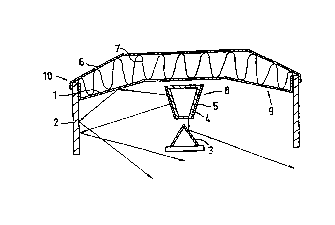Some of the information on this Web page has been provided by external sources. The Government of Canada is not responsible for the accuracy, reliability or currency of the information supplied by external sources. Users wishing to rely upon this information should consult directly with the source of the information. Content provided by external sources is not subject to official languages, privacy and accessibility requirements.
Any discrepancies in the text and image of the Claims and Abstract are due to differing posting times. Text of the Claims and Abstract are posted:
| (12) Patent Application: | (11) CA 2252608 |
|---|---|
| (54) English Title: | RADIATION HEATER |
| (54) French Title: | ELEMENT DE CHAUFFAGE A CHALEUR RAYONNANTE |
| Status: | Deemed Abandoned and Beyond the Period of Reinstatement - Pending Response to Notice of Disregarded Communication |
| (51) International Patent Classification (IPC): |
|
|---|---|
| (72) Inventors : |
|
| (73) Owners : |
|
| (71) Applicants : |
|
| (74) Agent: | SWABEY OGILVY RENAULT |
| (74) Associate agent: | |
| (45) Issued: | |
| (86) PCT Filing Date: | 1997-04-18 |
| (87) Open to Public Inspection: | 1997-10-30 |
| Availability of licence: | N/A |
| Dedicated to the Public: | N/A |
| (25) Language of filing: | English |
| Patent Cooperation Treaty (PCT): | Yes |
|---|---|
| (86) PCT Filing Number: | PCT/EP1997/001951 |
| (87) International Publication Number: | WO 1997040319 |
| (85) National Entry: | 1998-10-20 |
| (30) Application Priority Data: | ||||||
|---|---|---|---|---|---|---|
|
The invention relates to a radiation heater with a radiant tube surrounded by
a housing which has a reflector region guiding the heat radiation downwards.
The radiation heater can also be used in low spaces due to the fact that the
structure of the upper reflector region and/or lateral reflector regions
adjacent thereto and/or radiation surfaces of the radiant tube is such that
the heat radiation emerging from the housing has a distribution curve lowered
at the centre below the housing and raised in relation thereto on both sides.
L'invention concerne un élément de chauffage à chaleur rayonnante comportant un tube radiant entouré d'un boîtier qui présente une zone de réflecteur dirigeant le rayonnement thermique vers le bas. Cet élément de chauffage à chaleur rayonnante peut être utilisé même dans des locaux de faible hauteur car la zone supérieure du réflecteur et/ou les zones latérales du réflecteur adjacentes à la zone supérieure et/ou les faces de rayonnement du tube radiant sont conçues de sorte que le rayonnement thermique sortant du boîtier présente une courbe de répartition abaissée au centre sous le boîtier et élevée de part et d'autre de cette zone centrale.
Note: Claims are shown in the official language in which they were submitted.
Note: Descriptions are shown in the official language in which they were submitted.

2024-08-01:As part of the Next Generation Patents (NGP) transition, the Canadian Patents Database (CPD) now contains a more detailed Event History, which replicates the Event Log of our new back-office solution.
Please note that "Inactive:" events refers to events no longer in use in our new back-office solution.
For a clearer understanding of the status of the application/patent presented on this page, the site Disclaimer , as well as the definitions for Patent , Event History , Maintenance Fee and Payment History should be consulted.
| Description | Date |
|---|---|
| Time Limit for Reversal Expired | 2002-04-18 |
| Application Not Reinstated by Deadline | 2002-04-18 |
| Deemed Abandoned - Failure to Respond to Maintenance Fee Notice | 2001-04-18 |
| Inactive: IPC assigned | 1999-01-11 |
| Inactive: First IPC assigned | 1999-01-11 |
| Classification Modified | 1999-01-11 |
| Inactive: IPC assigned | 1999-01-11 |
| Inactive: Notice - National entry - No RFE | 1998-12-18 |
| Application Received - PCT | 1998-12-11 |
| Application Published (Open to Public Inspection) | 1997-10-30 |
| Abandonment Date | Reason | Reinstatement Date |
|---|---|---|
| 2001-04-18 |
The last payment was received on 2000-04-03
Note : If the full payment has not been received on or before the date indicated, a further fee may be required which may be one of the following
Please refer to the CIPO Patent Fees web page to see all current fee amounts.
| Fee Type | Anniversary Year | Due Date | Paid Date |
|---|---|---|---|
| Basic national fee - small | 1998-10-20 | ||
| MF (application, 2nd anniv.) - small | 02 | 1999-04-19 | 1998-10-20 |
| MF (application, 3rd anniv.) - small | 03 | 2000-04-18 | 2000-04-03 |
Note: Records showing the ownership history in alphabetical order.
| Current Owners on Record |
|---|
| STEFAN KEMNA |
| Past Owners on Record |
|---|
| None |